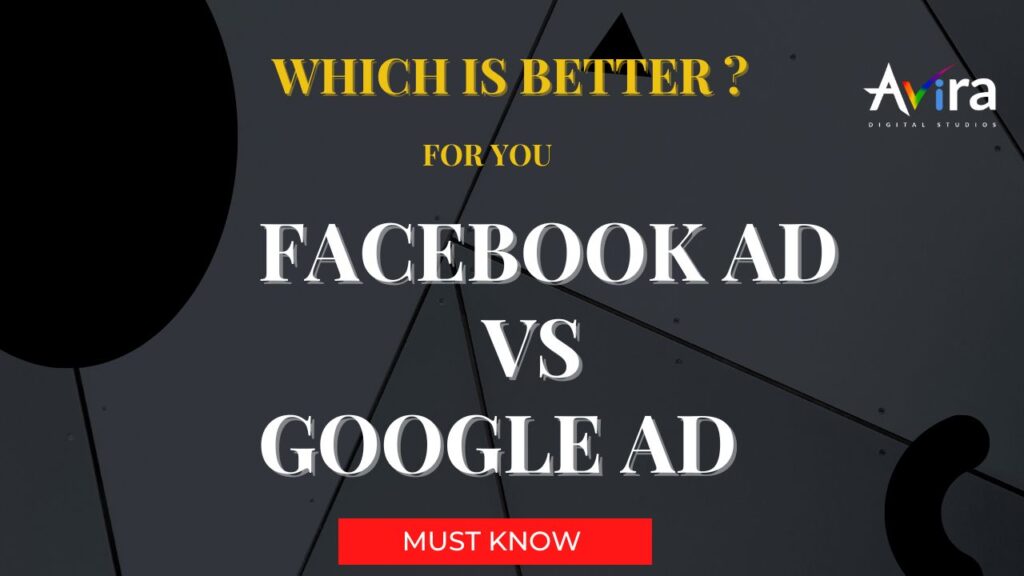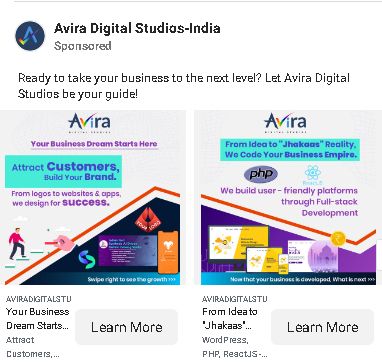Advertising is the bridge between a product and its potential customers, connecting needs with solutions but have wondered how to run Facebook and Google Ads? Do you know the different aspects of these digital advertising platforms? Avira Digital Studios is going to help you find out the results of Google ads vs Facebook ads in this blog.

Facebook Ads vs. Google Ads : What is Facebook Ads ?
Facebook Ads is a powerful tool for businesses to promote products or services on its platform. It allows you to create customized advertisements that reach specific audiences based on a few parameters like demographics, interests, and behaviors. With Facebook Ads, you can set a budget, target the right people, and track the performance of it in real time. It’s an effective way to increase brand awareness, drive website traffic, and generate leads for your business.
Example of Facebook Ads :

Advantages of Facebook Ads :
Here, we have mentioned the top 5 advantages of Facebook ads.
1. Targeted Reach:
Facebook’s extensive user data allows you to precisely target an audience based on demographics ( age, gender, location), interests (hobbies, activities, pages liked), and behaviors (purchase history, device usage). This targeting ensures that your ads are seen by the most relevant audience, increasing the chances of conversion.
2. Cost-Effective:
On Facebook, advertisers can set their budget and bid strategy and can control how much they spend on each ad campaign. This flexibility allows businesses of all sizes to participate in advertising on Facebook which makes it accessible and cost-effective. Additionally.
3. Engagement Opportunities:
Facebook offers a variety of ad formats that encourage user interaction and engagement with brands. For example, carousel ads allow advertisers to showcase multiple products or features in a single ad unit.
4. Analytics and Insights:
Facebook provides you with comprehensive analytics and reporting tools to track the performance of ad campaigns. Advertisers can monitor metrics such as reach, impressions, clicks, conversions, and more. It allows you to measure the effectiveness of ads and make data-driven decisions to optimize future campaigns.
5. Brand Awareness:
Facebook ads help increase brand visibility and awareness. It consistently exposes your brand to potential customers through targeted advertising. It can help reinforce brand recognition and loyalty over time. Moreover, Facebook’s social nature allows users to engage with your ads by liking, commenting, and sharing.
Facebook Ads vs Google Ads: How do you run Facebook Ads?
If you want to run Facebook ads then it involves 10 steps to ensure effective targeting, messaging, and optimization. Here’s a guide from Avira Digital Studios.
1. Define Your Objective:
Determine your advertising goal. It could be to drive website traffic, increase brand awareness, generate leads, or boost sales.
2. Set Up Facebook Business Manager:
Create a Business Manager account on Facebook. This platform allows you to manage your Facebook ads, Pages, and other assets in one place.
3. Create a Facebook Ad Account:
Within the Business Manager, set up a new ad account. This account is where you’ll manage your ad campaigns and budget.
4. Identify Your Target Audience:
Use Facebook’s targeting options to define your audience based on demographics, interests, behaviors, and more. Narrow down your target to reach the most relevant users for your ads.
5. Choose Ad Placement and Format:
You have to select where your ads will appear (Facebook, Instagram, Audience Network, Messenger) and choose the ad format that best suits your goals from image, video, carousel, etc.
6. Set Your Budget and Schedule:
The next step is to decide how much you want to spend on your ads and set a daily or lifetime budget.
7. Create Compelling Ad Creative:
Develop engaging ad content that grabs attention, communicates your message effectively, and encourages action. Ensure your visuals and copy are optimized for your target audience.
8. Set Up Tracking and Conversion Events:
You implement facebook pixel on your website to track conversions and optimize your ads for specific actions.
9. Launch Your Ad Campaign:
Review all settings and configurations to ensure everything is set up correctly. Once you are satisfied, launch your ad campaign and monitor its performance closely.
10. Monitor and Optimize:
Regularly check your ad performance metrics (such as reach, engagement, conversions, and return on ad spend) in Facebook Ads Manager. You can use these data to make informed adjustments to your targeting, creativity, and budget to optimize campaign performance over time.
By following these steps, you can effectively plan, launch, and manage Facebook ad campaigns to achieve your marketing objectives.
Facebook Ads vs Google Ads : What is Google Ads
Google Ads is an online advertising platform developed by Google that allows businesses to display ads on Google’s search engine results pages and its advertising network. Through Google Ads, advertisers like you can bid on keywords relevant to products or services, and your ads are displayed to users searching for those terms. Google ads which is also known as the per-click (PPC) advertising system enable businesses to reach their target audience and drive traffic to their websites effectively.
Facebook vs Google Advertising : Advantages of Google Ads :
In Facebook vs Google Advertising, here we are looking into the advantages of Google Ads.
1. Specific Targeting :
Google Ads allows you to show your ads to specific keywords, demographics, locations, and devices which ensures that your message reaches the most relevant audience. This precise targeting increases the chances of engaging potential customers who are actively searching for products or services like yours which leads to higher conversion rates and a better return on investment (ROI).
2. Economical:
With PPC Ads, you have full control over the advertising budget, allowing you to set daily or monthly spending limits that align with your financial goals. Additionally, the pay-per-click (PPC) model means you only pay when users click on your ads, ensuring that you’re only spending money when potential customers are actively interested in your offerings.
3. Immediate Results:
Organic search engine optimization can take time to produce results, and Google Ads campaigns can start driving traffic to your website almost immediately after your launch. This instant visibility enables you to quickly test different ad creatives, offers, and landing pages to optimize performance and achieve your marketing objectives.
4. Result Tracking:
Google Ads provides analytics tools that allow you to track key metrics such as clicks, impressions, conversions, and more in real time. This data-driven approach helps you to make informed decisions about your advertising strategy. It identifies areas for improvement and optimizes your campaigns to maximize ROI and achieve better results over time.
5. Brand Exposure:
Google Ads increases your brand’s visibility and exposure to a wide audience of potential customers. This increased brand awareness not only drives immediate traffic and conversions but also helps to build trust and credibility with your audience which ultimately leads to long-term business growth and success.
How do you run Google Ads :
We have listed 10 steps to run a Google Ads campaign
1. Account Creation:
The journey begins with a registration for a Google Ads account through the official platform using your business email address.
2. Budget Allocation:
Determine your advertising budget while considering your business objectives, financial capacity, and desired campaign duration.
3. Campaign Selection:
Now, you need to choose the most suitable campaign type among Search, Display, Video, or Shopping ads, aligning with your specific marketing goals.
4. Ad Group Organization:
Structure your ads into relevant ad groups, and group these according to themes or specific products/services to streamline management and optimization efforts.
5. Ad Copy Crafting:
Develop attractive ad copy that effectively communicates your unique value propositions and encourages user engagement and click-throughs.
6. Keyword Selection:
This is one of the most important parts of Google search ads. You conduct thorough keyword research to identify relevant keywords that align with your business offerings and target audience’s search queries.
7. Bid Strategy Implementation:
Set your bidding strategy, determine the maximum amount you’re willing to pay for each click and allocate your budget appropriately.
8. Landing Page Optimization:
Design and optimize dedicated landing pages on websites that align with ad content and provide a seamless user experience.
9. Campaign Launch:
Check all campaign settings and configurations to ensure accuracy and alignment with your business objectives before launching.
10. Performance Monitoring and Optimization:
Continuously monitor campaign performance metrics such as click-through rates, impressions, and conversions. Make data-driven adjustments and optimizations to improve campaign effectiveness and maximize ROI over time.
By adhering to these professional steps, business owners can effectively leverage Google Ads to promote their products or services, reach their target audience, and achieve their marketing objectives with precision and efficiency
Facebook Ads vs Google Ads Cost :
The cost of PPC Ads and Facebook Ads can vary based on various factors such as industry, target audience, ad format, and competition. Generally, Google Ads tend to have a higher average cost per click due to the competitive nature of keyword bidding. It is very high for popular keywords and industries. However, Google Ads offers a higher return on investment (ROI) for businesses targeting users with high intent. These users search for products or services.
On the other hand, Facebook Ads typically offer lower CPCs and cost-per-thousand-impressions (CPMs), which makes it more affordable for businesses aiming to reach a broader audience or build brand awareness. Ultimately, the choice between Google Ads and Facebook Ads depends on the specific goals, target audience, and budget of the advertiser.
Facebook Ads vs Google Ads : Final Words
Facebook Ads and Google Ads offer unique advantages and cater to different marketing objectives. The choice between these two ultimately depends on a few factors such as target audience, advertising goals, budget, and industry.
Facebook Ads excel in reaching a highly targeted audience based on interests, demographics, and behaviors which makes them ideal for brand awareness, engagement, and social media marketing.
On the other hand, Google Ads specializes in capturing users with high intent, which leverages search intent and keyword targeting to drive direct response and conversions. Therefore, businesses should carefully evaluate their specific needs and objectives to determine which platform best aligns with their advertising strategies and the highest return on investment.
If you want to know the latest updates on design, development , and marketing, follow the blogs of Avira Digital Studios
Connect With Us :

Design, Development, Marketing Company in Kolkata- Avira Digital Studios :
13, Barrackpore Trunk Road, Netaji Colony, Nainan Para, Baranagar, Kolkata, West Bengal 700036

